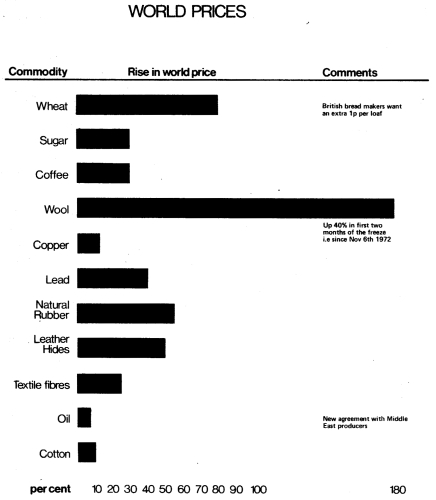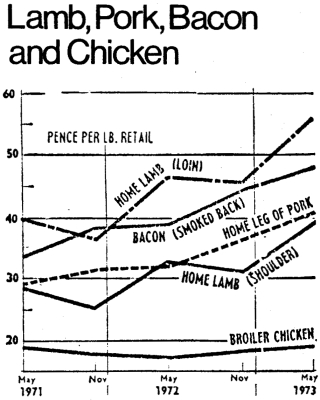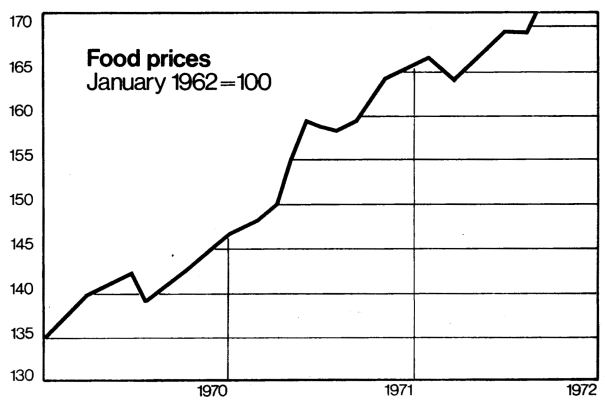
ISJ Index | Main Newspaper Index
Encyclopedia of Trotskyism | Marxists’ Internet Archive
From International Socialism, No.57, April 1973, pp.12-13.
Transcribed & marked up by by Einde O’Callaghan for ETOL.
 |
Government will try to restrict increases in wages and salaries to 8 per cent during Phase II. After tax and other deductions this would mean only 6 per cent improvement in average take-home pay. Against this must be set the long list of price increases which will be allowable under the freeze.
Council rent increases scheduled for 1973 under Housing Finance Act to be introduced as planned. Small improvements in rebate scheme, but higher rents expected to add about 1 per cent to Price Index. (Rents have increased 30 per cent since the Tories came to power)
To be introduced April 1st.
- If rate of VAT 10 per cent – Price Index up by 2.4 per cent.
- If rate of VAT 7½ per cent – Price Index up by 1.1 percent.
Extra administrative costs of VAT probably about £300 million, mainly to employ an estimated 6,000 extra civil servants, plus possibly as many as 50,000 extra clerks in industry.
Many firms will take advantage of VAT to jack up prices anyway. Administrative chaos would prevent effective policing, even if Government gave a damn. E.g. by mid-February, 500,000 of the 1,500,000 firms covered by VAT had still not complied with legal obligation to register. Customs and Excise report that 1 in 8 of the returns received from firms has to be returned because incorrectly completed.
An example of many thousands of detailed regulations which traders must assimilate ... if butcher sells unlabelled bag of scraps as catfood this is zero rated (i.e. no VAT). But if bag labelled (as ‘pussy pieces’ according to Customs and Excise) then VAT applies.
Examples of articles whose price will rise because of VAT:
|
Entry to this is expected to increase the price index by at least 2 per cent per year for 5 years (and by more than 2 per cent if the pound devalues further – cf. 6 below).
The Government and farmers argue that this is the biggest single factor in current acceleration of prices.
Counter Inflation Act allows increases in import prices to be passed on to consumer.
Imports include half the food consumed in Britain.
Food takes up 25 per cent of budget of average family, more in the case of low income groups. (Eg. pensioner couples spend 40 per cent of their income on food).
1972 – food import prices up by 25 per cent, and raw material prices up by 30 per cent.
A considerable part of these increases still to work through to retail prices, since bulk of increases concentrated into last few months of 1972 in one of most rapid booms in prices world has never seen. EG. in the three months before Freeze started in November British industry’s import costs rose by a fantastic 18 per cent, and by a further 17 per cent in the first two months of the Freeze.
1973 – On January 5th 1973, the Financial Times forecast that, ‘the indications are that the present upward trend in commodity prices will continue.’
Three main factors explain the current explosive rise in prices of food and raw materials imported into Britain.
- Inflation is now a world-wide phenomenon.
- World demand for food and commodities rising faster than supply.
- Devaluation of sterling raises import prices still further.
6. Devaluation
Every 5 per cent of devaluation equals 1 per cent on retail prices.
Prices have still not yet absorbed effect of 10 per cent devaluation after floating off in June 1972.
In February 1973, a further 5 per cent devaluation.
Prices to rise by 5-6 per cent on May 1st – a Common Market ruling.
Bank of England minimum lending rate, now at highest level since 1858. Interest rates correspondingly extortionate. Interest charges are roughly one fifth to one quarter of the rates bill for cities and towns (cf. 9 below).
The recent revaluation switched more of rate burden away from industry and on to domestic ratepayers. Also local authority finances devastated by high interest rates. Local Government Chronicle forecasts 12 per cent increase in rates this year. Others predict 20-25 per cent increase in the early months of 1973 (from rising interest rates). Rates have increased by 30 per cent since the Tories came to power.
In theory controlled by the Freeze. But companies allowed to make profits up to level of average of their two best years out of last five. Very generous. In 1972 profits rose by 14.9 per cent, and for January 1973 Financial Times reports, ‘Profits continued the healthy trends reported in latter part of 1972, and rose by 16.7 per cent in January.’ Legal restriction on profits easy to evade by accountancy fiddles, like speeding up annual allowances for depreciation of fixed capital. The scramble to raise profits has increased inflation – of food companies: Imperial Tobacco’s food division increased its profits by 40 per cent in 1972; Tesco’s by 30 per cent; Unilever’s by 14 per cent.
Fares have increased 42 per cent since the Tories came to power.
|
Retail prices |
|||
|---|---|---|---|
|
Freeze starts 6th Nov |
All items. |
Food |
Annual Rate |
|
Mid Oct.–mid Nov. |
+0.4 per cent |
+0.9 per cent |
10.8 percent |
|
Mid Nov.–mid Dec. |
+0.5 per cent |
+1.5 percent |
18.0 percent |
|
Mid Dec.–mid Jan. |
+0.6 per cent |
+2.0 per cent |
24.0 per cent |
In principle, prices cannot be controlled without a stringent rationing system. There are several million price changes each year, and 450,000 separate retail outlets.
In 1972 prices as a whole rose by 7 per cent. But the rise was most rapid for the two types of expenditure which figure most heavily in the average household budget. Food rose by 8 per cent, and housing costs by 14 per cent.
Among the more dramatic increases in 1972 were:
|
Since the Tories took office in June 1970, prices in general have risen by 25 per cent, and food prices by 30 per cent and Cheddar Cheese by 75 per cent.
In each of the first three months of the Freeze, prices rose more rapidly than in the previous month. The rate of acceleration was highest for food prices.
November ’72 to January ’73, 40 per cent increases in wholesale price of beef, 50 per cent rise in the price of lamb. Predicted rise of 10 per cent in price of chicken by June 1973. Meat shortage in Britain intensified by increasing exports of home produced meat to more profitable international markets. World scarcity of meat – USA and Japan have recently relaxed import quotas. Chile, once major exporter, now buying meat from Australia and New Zealand. ‘Meatless days’ introduced by Argentinian Government to leave some beef for export.
 |
Meat makes up 30 per cent of food budget of average household in Britain, but consumption dropping. From 1961 to 1971, average consumption of meat fell by 8 per cent. The decline has continued; during the first nine months of 1972, the average person’s meat intake declined from 16 oz. to 15.4 oz. per week. Figures for the latest period, when available, will show further and probably even more drastic decline in meat consumption as prices rocketed at the end of 1972.
|
‘Attempts by the Government to hold down food prices are foredoomed to failure. The era of cheap food is over ... only a system of rationing coupled with massive subsidies could hold down food prices in the face of rising world raw material costs, and no one in Government advocates this policy.’ |
|
‘Almost every official and economist concerned with the Freeze, irrespective of his politics, is primarily concerned to limit money wages; and the price control aspects are put in primarily as bargaining counters and public relations gestures.’ |
 |
ISJ Index | Main Newspaper Index
Encyclopedia of Trotskyism | Marxists’ Internet Archive
Last updated on 15.2.2008